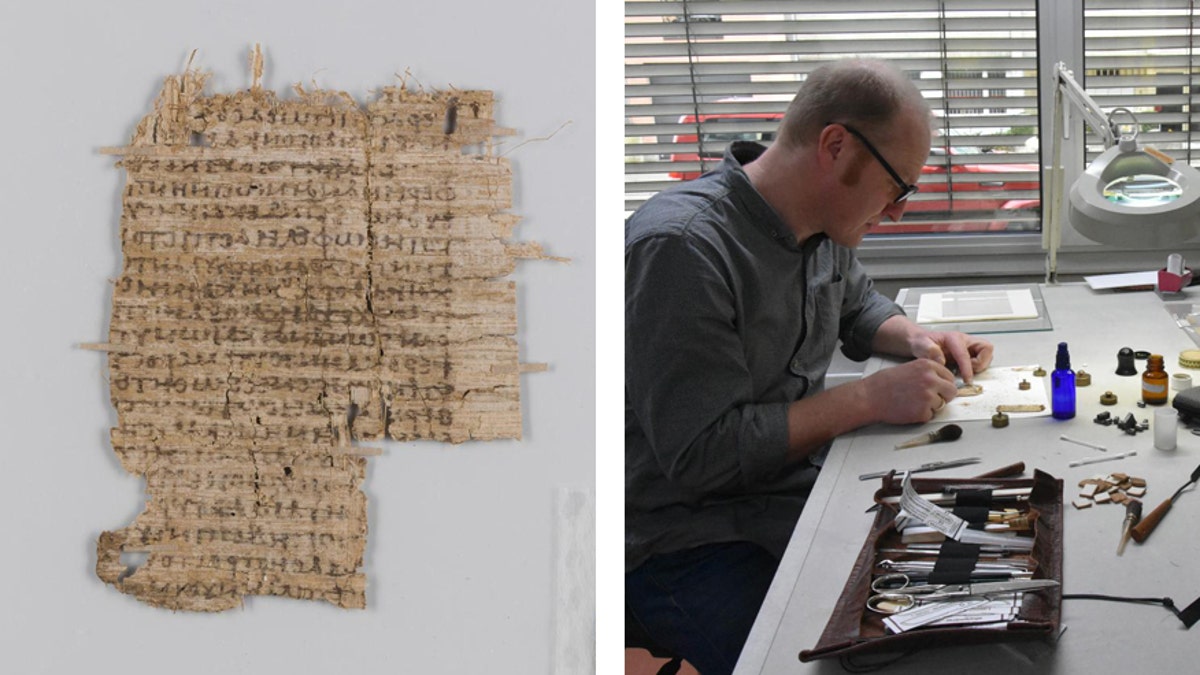
The mysterious ancient Greek document. (The University of Basel)
Scientists have finally unlocked the secrets of a mysterious 2,000-year-old papyrus document.
The strange artifact, which has mirror writing on both sides, has baffled experts for centuries. Written in ancient Greek, the papyrus has been in the possession of the University of Basel in Switzerland since the 16th century.
Scientists have harnessed ultraviolet and infrared technology to decipher the papyrus, discovering that it is not a single papyrus, but several layers of papyrus glued together, according to the University of Basel. A specialist papyrus restorer was also brought in to separate the sheets.
15TH-CENTURY MANUSCRIPT WITH 'ALIEN' CHARACTERS FINALLY DECODED
"This is a sensational discovery," said Sabine Huebner, professor of ancient history at the University of Basel, in a statement. "The majority of papyri are documents such as letters, contracts and receipts. This is a literary text, however, and they are vastly more valuable."

Scientists at the University of Basel have deciphered the 2,000-year-old papyrus. (University of Basel)
Specifically, the papyrus contains an ancient medical text that describes “hysterical apnea,” according to Huebner, who says that the text is either by the Roman physician Galen or an unknown commentary on his work.
Researchers were able to compare the papyrus to the Ravenna papyri, historic documents from the Archdiocese of Ravenna in Italy. These include ancient manuscripts from Galen that were written over and re-used in the medieval era. “The Basel papyrus could be a similar case of medieval recycling, as it consists of multiple sheets glued together and was probably used as a book binding,” explained the University of Basel, in its statement.
DEADLY DISCOVERY: POISONOUS BOOKS FOUND IN UNIVERSITY LIBRARY
Other historic texts have also been in the news recently. Scientists in Denmark, for example, recently found high levels of arsenic in three books from the 16th and 17th centuries. Experts from the University of Southern Denmark made the startling discovery when they were studying fragments of medieval manuscripts that were used to bind the books.

An expert works on the ancient papyrus. (University of Basel)
Earlier this year, secret 500-year-old letters sent by King Ferdinand II of Aragon to one of his military commanders were finally deciphered by experts in Spain. The country’s Army Museum called in experts from Spain’s intelligence agency, the Centro Nacional de Inteligencia (CNI), to help decipher the mysterious documents. The letters, which use a combination of 237 letter codes and 88 symbols, had baffled historians.
Ferdinand sent the letters to Gonzalo Fernández de Córdoba, known as the Great Captain, during a military campaign in Italy in the early 16th century.
SPAIN CRACKS SECRET CODE ON KING FERDINAND'S MYSTERIOUS 500-YEAR-OLD MILITARY LETTERS
Researchers in Canada also said they had harnessed artificial intelligence to decode a mysterious 15th-century manuscript. Discovered in the 19th century, the Voynich manuscript uses “alien” characters that have long puzzled cryptographers and historians.
Follow James Rogers on Twitter @jamesjrogers
